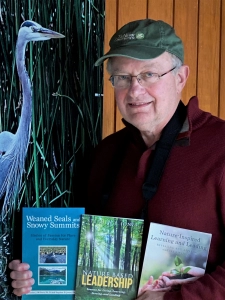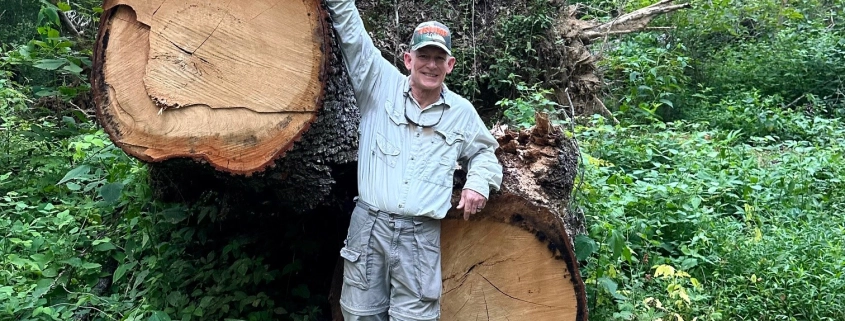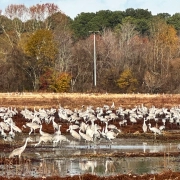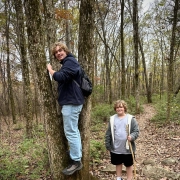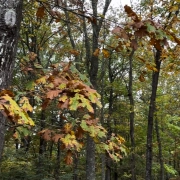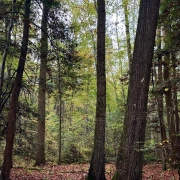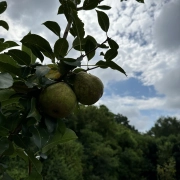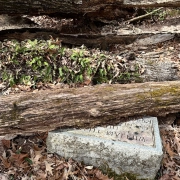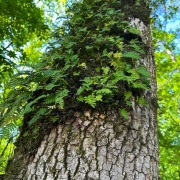Huge White Oak Blowdown and Cleanup at Wheeler National Wildlife Refuge!
Note: I am flagging this photo essay as one of a sub-series that introduces the emerging Singing River Trail (SRT):
A 200+ mile greenway system that strengthens regional bonds and creates new health and wellness, educational, economic, tourism, and entrepreneurial opportunities for the people and communities of North Alabama.
Nature’s Twin Blades: Fury and Glory
I measured more than nine inches of rain in the first 25 days of May 2025, much of it falling in drenching thunderstorms. I visited the nearby Wheeler National Wildlife Refuge’s bottomland forests on May 26, 2025, and encountered numerous blowdowns across and along the roads I frequently use. One particular fallen giant, within a few hundred yards of where the SRT will traverse the refuge, caught my attention. It lay across a road fifty feet beyond a gate bearing a sign directing all comers: Do Not Block Gate!
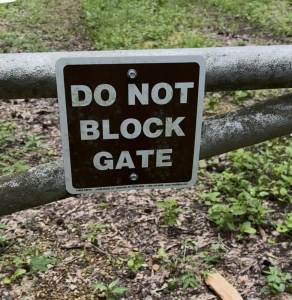
The massive twin-boled white oak barred the way. Who says Nature doesn’t appreciate irony!
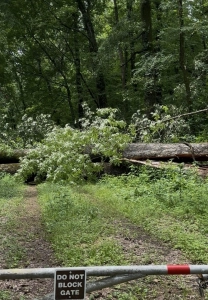
Each trunk exceeded three feet in diameter. Its girth and crushing weight tore the ground asunder, resembling a disaster area.
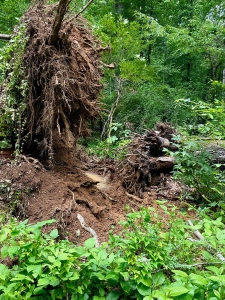
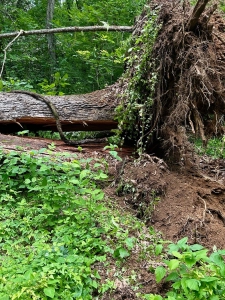
The fallen mammoth evidenced Nature’s power. I wondered whether the storm generated warning sufficient to have discouraged me from a woodland venture that day. Even I, a confirmed storm nerd, would have been terrified (and perhaps worse) caught in such a tempest.

The giant’s crown occupied a one-fifth-acre of sky, for which adjacent trees will compete, extending branches and emerging leaves to mine the newly available sunlight. As the trees attempt to exploit the opening, vegetation below will immediately tap the rays reaching the forest floor. Perrenials will rejoice with leaf surface flourish. Seedlings previously languishing in the shade will burst skyward toward the 10,000 square feet of open sky and full sunlight above.
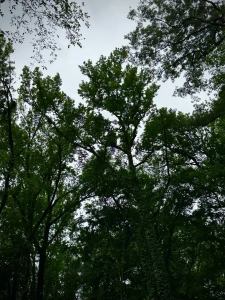
I recorded this 60-second video at the gate on May 26, 2025.
This 58-second video focuses on the massive soil disruption from the savaged trees and shows the crown void above.
July 2, 2025, Return to the Site!
Fellow Nature enthusiast Dr. Bernard Kerecki, accompanied me to wander nearby bottomland forests. We stopped at the Do Not Block gate. Dr. Kerecki stood by the twin boles of our toppled oak. The tree shows sound wood. No decay weakened this forest sentinel, predisposing it to structural failure.
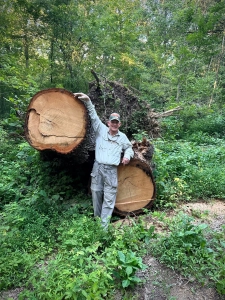
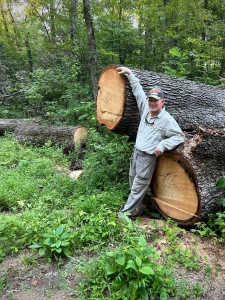
I estimated the tree’s age at 80-100 years with only a cursory look at the cross-section.
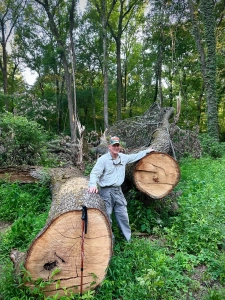
Here is the 59-second video I recorded on July 2.
Feeling guilty (how about stupid!) for not taking time to count the rings on July 2, I returned with 17-year-old grandson Jack, on July 7.
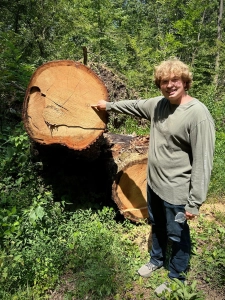
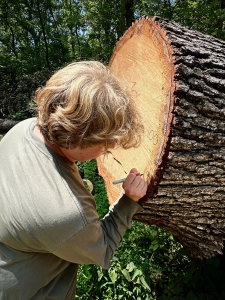
We counted the annual rings 10-12 feet above what had been ground level. The cambium, the growing layer just within the bark, where all new wood is added, was 119 rings from the center. Assuming that the tree may have reached that height in ten years, I conclude that this sentinel sprouted from an acorn 1n 1896, some 30 years after the Civil War ended at Appomattox, and 55 years before my birth, and about the same date my grandparents entered the world. I mused, what will Jack see if he were to return to the Do Not Block Gate when he is my age?
Here’s the brief video I recorded on July 7.
I have declared for the eight years I have wandered these bottomland forests that they are 80-90 years old, originating during the Wheeler Dam planning and construction era when TVA acquired inundation-destined and buffer lands. I’ll stay with that generalized assumption, recognizing that 90 years ago the refuge was a mosaic of abandoned agriculture, established forest, and sundry wetlands. Our subject tree is considerably larger with a demonstrably coarser, spreading crown. It stands at the edge of a tilled field. It may have stood at a boundary even in 1935.
The annual growth rings on a ring-porous oak tree are distinct. Jack and I marked ten-year increments with a Sharpie (below right). The 50th ring marks 1956. The gates on Wheeler Dam closed two ten-year increments earlier.
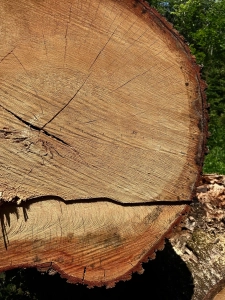
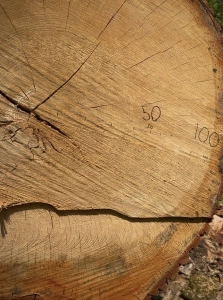
I observe often that nothing in Nature is static. A windthrown dominant individual does not renew the one-fifth-acre forest directly affected. Adjoining trees and new recruits will respond, but the bottomland forest surrounding it will remain materially intact. I routinely see such fallen, diseased, and standing dead giants. What I do not see is evidence of a new emerging forest type. This extensive forest on the WNWR is changing tree-by-tree-by-tree, but I am unable to predict its character 100 years hence. I will continue to monitor, observe, and reflect.
I am grateful for the chance to chronicle subtle change and document occasional significant events.
Closing
I reflect often on the twin blades of Nature…her fury and her glory. Alfred Noyes penned The Highwayman 120 years ago. Wind toppled ancient trees in the refuge’s rich bottomland forests brought to mind Noyes’ opening line:
The wind was a torrent of darkness among the gusty trees.
Thoughts and Reflections
I offer these observations:
- My wanderings often reveal the twin blades of Nature…her fury and her glory. (Steve Jones)
- Understanding Nature demands looking back and gazing ahead; what will become of these extensive bottomland forests? (Steve Jones)
- The more things change the more they stay the same. (Alphonse Karr)
Inhale and absorb Nature’s elixir. May Nature Inspire, Inform, and Reward you!
The Nature of the Singing River Trail
The Singing River Trail will be a 200+ mile greenway system that strengthens regional bonds and creates new health and wellness, educational, economic, tourism, and entrepreneurial opportunities for the people and communities of North Alabama.
The trail will prominently feature the 35,000 acre Wheeler National Wildlife. A planned route segment will include Rockhouse Bottom Road, which is within a quarter-mile of the Do Not Block Gate! My hope is that SRT venturers can search these Great Blue Heron Posts to better understand the Nature of our region.
As a lifelong devotee of hiking/sauntering, running, biking, and Nature exploration, I envision another Great Blue Heron weekly photo essay series focused on The Nature of the Singing River Trail. I will incorporate individual essays into my routine Posts that total approximately 450 to-date (archived and accessible at: https://stevejonesgbh.com/blog/). I offer Wheeler National Wildlife Refuge related photo essays as an orientation to the new component series.
Note: All blog post images created & photographed by Stephen B. Jones unless otherwise noted. Please circulate images with photo credit: “©2025 Steve Jones, Great Blue Heron LLC. All Rights Reserved.”
I am available for Nature-Inspired Speaking, Writing, and Consulting — contact me at steve.jones.0524@gmail.com
Reminder of my Personal and Professional Purpose, Passion, and Cause
If only more of us viewed our precious environment through the filters I employ. If only my mission and vision could be multiplied untold orders of magnitude:
Mission: Employ writing and speaking to educate, inspire, and enable readers and listeners to understand, appreciate, and enjoy Nature… and accept and practice Earth Stewardship.
Vision:
- People of all ages will pay greater attention to and engage more regularly with Nature… and will accept and practice informed and responsible Earth Stewardship.
- They will see their relationship to our natural world with new eyes… and will understand more clearly their Earth home.
Tagline/Motto: Steve (Great Blue Heron) encourages and seeks a better tomorrow through Nature-Inspired Living!
Steve’s Four Books
I wrote my books Nature Based Leadership (2016), Nature-Inspired Learning and Leading (2017), Weaned Seals and Snowy Summits: Stories of Passion for Place and Everyday Nature (2019; co-authored with Dr. Jennifer Wilhoit), and Dutton Land & Cattle: A Land Legacy Story (2023) to encourage all citizens to recognize and appreciate that every lesson for living, learning, serving, and leading is either written indelibly in or is powerfully inspired by Nature. All four of my books present compilations of personal experiences expressing my deep passion for Nature. All four books offer observations and reflections on my relationship with the natural world… and the broader implications for society. Order any from your local indie bookstore, or find them on IndieBound or other online sources such as Amazon and LifeRich.
I began writing books and Posts for several reasons:
- I love hiking and exploring Nature
- I see images I want to (and do) capture with my trusty iPhone camera
- I enjoy explaining those images — an educator at heart
- I don’t play golf!
- I do love writing — it’s the hobby I never needed when my career consumed me
- Judy suggested my writing is in large measure my legacy to our two kids, our five grandkids, and all the unborn generations beyond
- And finally, perhaps my books and Blogs could reach beyond family and touch a few other lives… sow some seeds for the future
